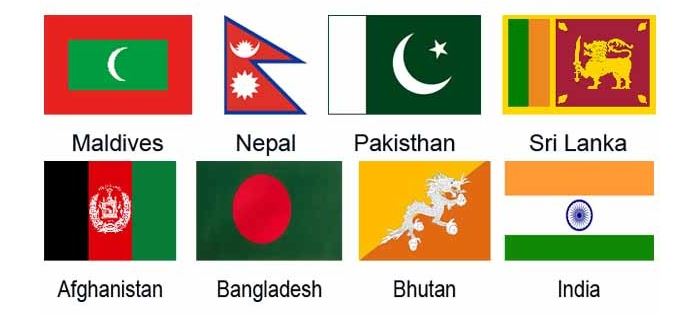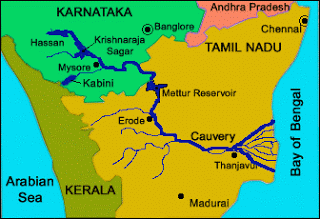Video Conference of SAARC Leaders on COVID-19
Why in News
The Video Conference of South Asian Association for Regional Cooperation (SAARC) Leaders on COVID-19 was held recently.
- All the members of SAARC (India, Bangladesh, Bhutan, Nepal, Maldives, Sri Lanka, Afghanistan and Pakistan) attended the conference.
- The conference is considered as a step towards the revival of SAARC as the SAARC Summit has not taken place since 2014 because of India-Pakistan tensions.
Key Points
- COVID-19 Emergency Fund:
- India has proposed to create a COVID-19 Emergency Fund which could be based on a voluntary contribution from all SAARC members.
- Further, $10 million has been extended by India as a contribution to the fund.
- The fund can be used to meet the cost of immediate actions by any member and will be coordinated through foreign secretaries and embassies of the member countries.
- The World Health Organisation (WHO) has also constituted the COVID-19 Solidarity Response Fund with the help of corporate bodies, foundations and the UN Foundation.
- Other Proposals by India:
- India has also proposed a rapid response team of doctors and specialists, along with testing kits and other equipment for all the member countries.
- India has set up an Integrated Disease Surveillance Portal to better trace possible virus carriers and the people they contacted. India has offered to share it with member countries.
- Economic Issues and Measure:
- The conference also discussed longer-term economic consequences of COVID-19.
- The member countries have also proposed to insulate internal trade of South Asia and local value chains from its impact.
- Measures by SAARC to Manage Health Pandemics:
- It has been decided to frame and enforce the common SAARC pandemic protocols.
- The members have also decided to establish a working group of national authorities for health information, data exchange and coordination in real-time.
- It has also proposed a SAARC health ministers’ conference and the development of regional mechanisms to share disease surveillance data in real-time.
- Country-Specific Issues:
- Afghanistan has highlighted the vulnerability as it shares a long and open border with Iran, one of the worst affected countries in the world.
- The Maldives has cited the economic downturn owing to the drop in tourists inflow from Italy, China and Europe - the main source of tourists for the country and sought a South Asian response to the crisis.
- The tourism-dependent countries like Bhutan, Sri Lanka has also sighted issues related to the economic slowdown.
Successful Trails in Treating Drug-Resistant TB
Why in News
Recently, a small trial was undertaken to test the safety and efficacy of a few oral drugs against the extensively drug-resistant TB (XDR-TB) and multidrug-resistant TB (MDR-TB).
- The trial showed encouraging results with a success rate of 90%.
- The favourable results held true regardless of the HIV status of the patients.
Key Points
- The trial (Nix-TB) tested three oral drugs namely bedaquiline, pretomanid and linezolid in patients with XDR-TB and MDR-TB.
- Success Rate
- The 90% treatment success in the case of hard-to-treat patients is at par with the success rate seen while treating drug-sensitive TB.
- Of the 109 patients treated, 11 had unfavourable outcomes.
- Of the 11 patients, there were seven deaths and two had a relapse during the six-month follow-up period.
- The treatment success rate was 89% for XDR-TB and 92% for MDR-TB.
- The MDR-TB patients included in the trial were either not responsive to standard treatment or had discontinued treatment due to side effects.
Tuberculosis
- It is caused by bacteria (Mycobacterium tuberculosis) that most often affect the lungs.
- Transmission: TB is spread from person to person through the air. When people with lung TB cough, sneeze or spit, they propel the TB germs into the air.
- Symptoms: Cough with sputum and blood at times, chest pains, weakness, weight loss, fever and night sweats.
- Treatment: TB is treatable and curable disease. It is treated with a standard 6 month course of 4 antimicrobial drugs that are provided with information, supervision and support to the patient by a health worker or trained volunteer.
Multidrug-resistant Tuberculosis
- It is a form of TB caused by bacteria that do not respond to isoniazid and rifampicin, the 2 most powerful, first-line anti-TB drugs.
- MDR-TB is treatable and curable by using second-line drugs.
Extensively drug-resistant Tuberculosis
- It is a more serious form of MDR-TB caused by bacteria that do not respond to the most effective second-line anti-TB drugs, often leaving patients without any further treatment options.
OneHealth Approach
Why in News
Recently, to deal with zoonotic diseases, a need to operationalize “OneHealth’ policy in India was highlighted.
- Presently, India is dealing with coronavirus (COVID-19). The virus appears to have its origin in bats.
OneHealth
- OneHealth is an approach to designing and implementing programmes, policies, legislation and research in which multiple sectors communicate and work together to achieve better public health outcomes.
- The areas of work in which a One Health approach is particularly relevant include food safety, the control of zoonotic diseases (diseases that can spread between animals and humans, such as flu, rabies and Rift Valley Fever), and combating antibiotic resistance (when bacteria change after being exposed to antibiotics and become more difficult to treat).
- Although OneHealth, as a conceptual entity, emerged relatively recently, a stellar example of OneHealth being operationalised in the field was seen in India in the late 1950s.
Zoonotic Diseases
- The diseases, which “spillover” from animals to humans are referred to as zoonotic diseases
- They represent more than 60% of emerging infectious diseases worldwide.
- The destruction of the natural environment, globalised trade and travel and industrialised food production systems have created numerous pathways for new pathogens to jump between animals and humans.
India and OneHealth Approach
- In the 1950s, the OneHealth approach helped discover the source of Kyasanur Forest Disease (KFD), a highly dangerous haemorrhagic fever more threatening than COVID-19.
- This was the result of working of several organizations such as the Virus Research Centre (now known as the National Institute of Virology), Pune, the World Health Organization (WHO) and the Bombay Natural History Society.
- In 2018, Kerala reacted quickly and efficiently to tackle the Nipah virus outbreak and successfully managed to confine it to 23 cases.
- This success is credited to the strong public health infrastructure and the political will to quickly seek help from a multidisciplinary team of national and international experts.
- One of the components of the National Mission on Biodiversity and Human Well-being explicitly links biodiversity to human health through the OneHealth framework.
- However, the regulatory framework for doing OneHealth research in India with international collaboration typically requires approvals from multiple authorities. This hampers the country’s ability to rapidly respond to emerging threats from infectious diseases.
National Mission on Biodiversity and Human Well-being
- The mission aims to explore the neglected links between biodiversity science and human well-being across the sectors of health, economic development, agricultural production and livelihood generation, in combination with efforts to mitigate climate change and related disasters.
Way Forward
- The frequency with which new pathogens are emerging or old ones are re-emerging across the world are alarm calls for greater transparency, cross-country collaborations, and enhanced national infrastructure and capacity for integrated OneHealth science.
- India needs to leap-frog over the systemic and institutional barriers that prevent an integrated OneHealth framework from being operationalised.
- The OneHealth framework will help government and private institutions, across a range of disciplines, in collaborating to understand how zoonotic diseases can emerge, the threats they can pose, and the mechanisms by which the emergence or spread can be controlled.
Defence Fund Shortfall
Why in News
Recently, a Parliamentary Standing Committee on Defence has shown concern at the widening gap between projections and allocations in the defence budget.
- The Committee noted that since 2015-16, none of the three Services (Army, Navy and Air Force) has been given the matching allocation as per the projection.
Key Findings of the Committee
- There is a considerable shortage in the allocation in the Capital Head, which is 35% less than the projection.
- The Committee noted that committed liabilities constitute a significant part of the Capital Head and inadequate allocation would definitely lead to ‘default situation’ on contractual obligations.
- Committed liabilities are payments anticipated during a financial year for contracts concluded in previous years.
- Such a situation is not conducive for preparation of the country to modern-day warfare, where possession of capital intensive modern machines is a prerequisite for tilting the result of the war in favour and also to have a credible deterrence.
- Both the Navy and the Indian Air Force (IAF) have a situation where their committed liabilities are more than their share of the capital allocation in the Budget.
- To offset this, the Services have been forced to defer payment of committed liabilities of the Defence Public Sector Undertakings (DPSU) among other measures.
- The shortfall in expenditure will affect:
- Operationalisation of three tri-service organizations i.e. Defence Space Agency (DSA), Defence Cyber Agency (DCYA) and Armed Forces Special Operations Division (AFSOD).
- Operational readiness of Andaman and Nicobar Command (ANC).
- Maintenance of SIGINT (Signal Intelligence) equipment.
- Administration of training institutes and operational units.
- Recommendations:
- The committee has recommended a dedicated fund for committed liabilities and procurements before the shortfall impacts modernisation, invariably from next Budget onwards (2021-22).
Role of Glucose in Regulating Liver Functions
Why in News
A study by researchers from the Tata Institute of Fundamental Research, Mumbai (TIFR) has revealed that glucose in the body controls the function of SIRT1 directly.
- SIRT1 is an enzyme that deacetylates (removal of acetyl) proteins that contribute to cellular regulation (reaction to stressors, longevity).
- A shortage or absence of the control by glucose may lead to a diabetic-like state, while excess feeding and sustained low levels of SIRT1 can lead to obesity and enhanced ageing.
- This study paves the way might be beneficial in tackling lifestyle disorders and ageing-related diseases.
Key Points
- In normal healthy individuals, SIRT1 protein levels are known to increase during fasting and decrease during the feed, which is essential to maintain a balance between glucose and fat metabolism.
- The glucose controls the functions of a protein SIRT1 which in turn maintains everyday feed-fast cycles and is also associated with longevity.
- The feed-fast cycle is a basic pattern and the metabolism-related to this is largely taken care of by the liver.
- Thus, the study shows that both over-activation and under-activation of SIRT1 can lead to diseases.
- Glucose puts a check on the activity of SIRT1 in the fed state. In the absence of this check, SIRT1 activity increases and results in hyperglycemia in a fasted state, mimicking diabetic state.
- The constant feeding or high-calorie intake that leads to a sustained reduction in the levels of SIRT1 (by glucose) is associated with ageing and obesity.
New Website of Ministry of New and Renewable Energy
Why in News
- Recently, a new website of the Ministry of New and Renewable Energy was launched.
- The Ministry website hosts KUSUM Scheme Portal, Akshay Urja Portal and India Renewable Idea Exchange (IRIX) Portal.
KUSUM Scheme
- KUSUM stands for Kisan Urja Suraksha evam Utthaan Mahabhiyan. It’s objective is to provide financial and water security to farmers through harnessing solar energy capacities of 25,750 MW by 2022.
- The scheme consists of three components:
- Installation of ground mounted grid connected renewable power plants in the rural areas.
- Installation of standalone solar powered agriculture pumps.
- Solarisation of grid-connected agriculture pumps to make farmers independent of grid supply and also enable them to sell surplus solar power generated to DISCOM.
Benefits
- Stable and continuous source of income to the rural landowners.
- Availability of sufficient local solar/other renewable energy based power for feeding rural load centres and agriculture pump-set loads.
- Reducing transmission losses.
- Save the expenditure incurred on diesel for running diesel pumps.
- Substantial environmental impact in terms of savings of CO2 emissions.
India Renewable Idea Exchange (IRIX)
- IRIX is a platform that promotes the exchange of ideas among energy conscious Indians and the Global community.
Zoji La
- Zoji La is a high mountain pass located in the Kargil district of Ladakh.
- The pass links Leh and Srinagar and provides an important link between Union Territories of Ladakh and Kashmir.
- Zojila pass remains closed during winters due to heavy snowfall, cutting off Ladakh region from Kashmir.
- In 2018, the Zojila tunnel project was launched. The tunnel is Asia's longest and strategic bi-directional tunnel, which will provide all-weather connectivity between Srinagar, Kargil and Leh.
| Pass | Link/Features |
| Banihal Pass | Kashmir Valley with the outer Himalaya and the plains to the south. |
| Bara-Lacha-La Pass | Lahaul district in Himachal Pradesh with Leh district in Ladakh. |
| Fotu La Pass | Leh with Kargil of Ladakh |
| Rohtang Pass | Kullu Valley with the Lahaul and Spiti Valleys of Himachal Pradesh. |
| Shipki La Pass | Kinnaur district of Himachal Pradesh with Autonomous Region of Tibet, China. |
| Jelep La Pass | Sikkim with Autonomous Region of Tibet, China. |
| Nathu La Pass | Sikkim with Autonomous Region of Tibet, China. |
| Lipu Lekh Pass | Chaudans valley of India with Autonomous Region of Tibet, China. It is located close to the tri junction of Uttarakhand (India), China and Nepal. |
| Khardung La | Ladakh with Siachen glacier. It is the highest motorable pass in the world. |
| Bom di La | It is in Arunachal Pradesh |
Krishna Raja Sagar Dam
Why in News
The water level in the Krishna Raja Sagar (KRS) Dam in Mandya district (Karnataka) is coming down rapidly owing to the increase in the evaporation rate and the decrease in the inflows as a result of summer.
Key Points
- The Krishna Raja Sagar Dam was built across river Kaveri for the Mysore and Mandya districts in Karnataka in 1932.

- The dam is named for the then ruler of the Mysore Kingdom, Krishnaraja Wodeyar IV.
- The Dam is the creation of one of the greatest engineers that India had produced, Sir M. Vishweshwaraiah. His birthday, 15th September is celebrated as Engineers day.
- The reservoir is also the main source of drinking water for all of Mysore city and almost the whole of Bangalore.
- The water released from this dam is further used as an important source of water in the state of Tamil Nadu.
Kaveri River
- Source: The river rises on Brahmagiri Hill of the Western Ghats in southwestern Karnataka.
- Drainage Basin: It flows in a southeasterly direction through the states of Karnataka and Tamil Nadu, and descends the Eastern Ghats in a series of great falls. Before emptying into the Bay of Bengal south of Cuddalore, Tamil Nadu, the river breaks into a large number of distributaries forming a wide delta called the “garden of southern India.”
- Tributaries: Arkavathi, Hemavathi, Lakshmana Theertha, Shimsa, Kabini and Harangi.
Iron Rain on Exoplanet
Why in News
- Wasp-76b, an exoplanet (planet outside the solar system), probably has iron raining on it.
Key Points
- Wasp-76b orbits so close to its host star that its dayside temperatures exceed 2,400 degrees Celsius - hot enough to vaporise metals like iron.
- The planet's nightside, on the other hand, is 1,000 degrees cooler, allowing those metals to condense and rain out.
Wasp-76b
- Wasp-76b is a huge gas planet that is twice the width of Jupiter. Its name comes from the UK-led Wasp telescope system that detected it in 2016.
- The UK Wide Angle Search for Planets (WASP) is a collaborative project involving several UK universities. The primary aim is the discovery of exoplanets.
- It is 640 light-years from the Earth and is so close to its star that it takes just 43 hours to complete one revolution.
- Another of the planet's interesting features is that it always presents the same face to the star - a behaviour scientists call being "tidally locked". Earth's Moon does exactly the same thing.
- Tidal locking is the name given to the situation when an object’s orbital period matches its rotational period.
- The moon takes 28 days to go around the Earth and 28 days to rotate once around its axis. This results in the same face of the Moon always facing the Earth.
Tara Tarini Temple
Why in News
The annual Chaitra Jatra festival scheduled to be held on 17th March, 2020 at Odisha’s Tara Tarini hill shrine has been cancelled as a precautionary measure against COVID-19 infection.
- The festival is held on each Tuesday in the month of Chaitra, which falls in March-April as per the English calendar.
Key Points
- Tara Tarini hill shrine, located at a hilltop on banks of the Rushikulya river, is a major centre of Shakti worship in Odisha.
- The twin goddesses Tara and Tarini represent one Shakti and are the main deity of Ganjam district (Odisha).
- Tara is an important deity of Mahayana Buddhist Sect.
- This temple had been built as per traditional Rekha style of Odia temple architecture, as per which famous Jagannath temple of Puri and Lingaraj temple of Bhubaneswar have been built.
- Unlike other temples, it wasn’t built under the patronage of a King or a Noble, the temple was set up by a Brahmin named Basu Praharaj as per popular legend.
- Since its inception it has been an established seat of Tantrism.
- Indian Navy’s sailboat INSV Tarini was named after Tara Tarini hill shrine.The first Indian all-woman crew had circumnavigated the globe in INSV Tarini.
A New Study on Earth
Why in News
- Recently, a study on Earth’s spin was published in the American Geophysical Union’s journal Paleoceanography and Paleoclimatology.
- The study came after scientists studied a 70 million years old mollusc fossil from Oman.
Key Points
- The study states that Earth spun 372 times a year 70 million years ago, compared to the current 365 times. This means the day was 23½ hours long, compared to 24 hours today.
- It is important to note that the period of Earth’s orbit has remained the same. In other words, one year 70 million years ago was as long as one year today.
- Today, Earth’s orbit is not exactly 365 days, but 365 days and a fraction, which is why our calendars have leap years, as a correction.
- It has long been known that Earth’s spin has slowed over time.
- The study states friction from ocean tides, caused by the Moon’s gravity, slows Earth’s rotation and leads to longer days. And as Earth’s spin slows, the Moon moves farther away.
- The study states that the Moon's rate of retreat has changed over time.
ROPAX Service
Why in News
The Ministry of Shipping has launched a roll on-roll off cum passenger ferry service, called ‘ROPAX’, between Mumbai and Mandwa (Maharashtra).
- ROPAX service is a water transport service project under Eastern Waterfront Development.
- The road distance from Mumbai to Mandwa is about 110 kilometres, and it takes three to four hours, whereas by waterway the distance is about 18 kilometres and a journey of just an hour.
- ROPAX Vessel M2M -1 was built in Greece in September 2019. This Vessel has a speed of 14 knots and can carry 200 cars and 1000 passengers at a time. It is capable of operating even in a monsoon season.
- People will be able to travel in their cars directly on to the ROPAX vessel.
- The benefits of this service include reduction in the travel time, vehicular emission and traffic on the road.
Eastern Waterfront Development
- The Eastern Waterfront is the Mumbai Port Trust’s (MbPT’s) plan to develop the port lands across Mumbai’s eastern coast stretching from Sassoon Dock to Wadala.
- MbPT is an autonomous Body of the Government of India under the Ministry of Shipping.
- Some of the major proposals under the project include a 93- hectare park near Haji Bunder, around 17 hectares for tourism-related projects such as themed streets and affordable housing.
- The project also has a focus on a water transport by making a provision for water taxis, international and domestic cruises and ro-pax (roll on/roll off passengers) services.
